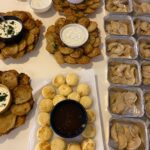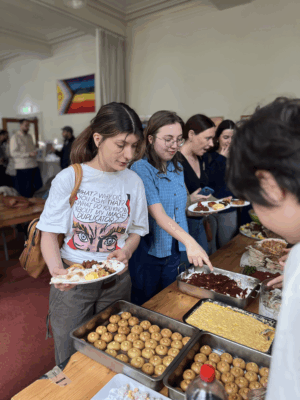


RPM's Turkish Culture Café
By Olianna Dimitropoulou and Claudia Acanfora
During Refugee Project Maastricht’s Turkish Culture Café on February 8th, a group of Turkish volunteers led the effort to prepare a variety of delectable dishes for more than 100 participants: Çiğköfte, Lahmacun, Mantı, Börek, Dolma, Şakşuka, Revani and Salata. Afterward, RPM volunteers had the pleasure of sitting down with the 4 of the talented cooks (one remaining anonymous) for an interview with translation assistance. We also received a recipe for a wonderful Turkish dessert called Şekerpare, to share with you all.
From the dishes that were presented today, which is your favorite to cook?
“Börek, dolma… All of them, actually (laughs).”
Are you normally used to cooking for big groups of people?
“Normally it’s in our culture to cook a lot, even individually. [But today] it was really fun cooking all together. While we’re cooking, everyone has their own space to cook and we respect but help each other at the same time. Everyone works together harmoniously.”
Do you make these dishes on an everyday basis, or save them for holidays or special occasions?
“We normally cook these dishes every day (all laugh).”
How did you learn how to cook?
“We firstly observe and learn how to cook from our mothers. But, we practiced and found our own style of cooking after marriage.”
One woman continues- “I decided to cook after my university years. One time I was trying to cook rice, and I put so much water it looked like soup. I tried many times. And my husband encouraged me to continue and find my own style of cooking.”
Are there any specific ingredients that you add to food and you can’t live without?
“It doesn’t matter if you have all the materials or not. If you don’t add love it will be tasteless. Back in time, during the war [Turkish War of Independence (1919–1923)], Turkish women needed to be creative. Using one ingredient, we could create such a variety of dishes.”
One woman continues- “Spices, though: [for me personally, those are] olive oil, butter, tomato paste. While I’m cooking, I’m trying to imagine the end product. I’m thinking about my family, my children, and my husband – that’s what motivates me to cook. It’s like making art and harmony by using all ingredients. Everyone can paint. But the end product is different from everyone.”
Are there different variations of the dishes?
“It’s all about the way you cook. The recipe is the same, but the ingredients everyone uses differs. It has to do with the taste of your hands, the taste of your mouth. If we both make the same recipe, it will taste different.”
Translator- “I’d like to add something: In Turkey we have seven different regions. Everywhere you go, the tastes change. In the East side of Turkey they’re mostly using butter and dairy, but in the West they’re mostly using olive oil and some Mediterranean influences.”
If you had to pick a dish that a beginner can make, which recipe would you suggest?
“(All together) Menemen (laughter). It has chopped pepper, tomato, olive oil, butter, onion, eggs and optional garlic.”
What drinks do you normally serve with these dishes?
“Ayran: yogurt with water and mint and a bit of salt. Turnip juice too: şalgam suyu.”
And Turkish tea?
“Next to these dishes, we don’t serve Turkish tea; we mostly drink ayran. But, we serve tea all day, from the beginning of the day to the end. When you invite your friend to your house and you want to serve something, Turkish tea is a must.”
Thank you for your time. Do you have a last message you want people to hear?
“In Turkey we have seven regions. Each city has their own famous food. Once you decide to talk about Turkish cuisine, it’s almost impossible to discuss. As I [translator] was saying before, from East to West the flavors and dishes change. North, in the Black Sea Region, we have so many fish dishes. In the middle, it’s mostly patisserie, dumplings or börek as we call it. In the East, it’s a lot of meat, and in the West, it’s a lot of vegetables. In the Aegean region, Greek cuisine is literally the same. This is because in Turkey we have four seasons and the landscape is so huge, so it depends on the climate. For example, in the Aegean it’s a milder climate. And our food is also influenced by different cultures; we have a lot of neighbors.”
“[But at the core] whether we are cooking food together or serving it, it’s our love language. Hospitality is so important for us. When someone visits our home as a guest, we bring out at least 3 different foods. That is a must.”
INGREDIENTS
(Yields approximately 35 cookies)
For the cookies:
150 g butter
3.5 cups (560g) flour
3 eggs
1 small tea glass (100g) semolina (durum wheat)
1 small tea glass (100g) powdered sugar
1 packet baking powder
1 packet vanilla
½ small tea glass (100g) sunflower oil
Hazelnuts (for topping)
For the syrup:
3.5 cups (560g) granulated sugar
3.5 – 4 cups (560 – 640g) water
1 slice of lemon
To make the dough: In a mixing bowl, add flour, semolina, powdered sugar, vanilla, and baking powder. Mix them well. Make a hole in the center and add the butter, sunflower oil, and eggs. Start kneading from the center, incorporating the dry ingredients gradually, until you get a soft, pliable dough.
Shape the cookies: Knead the dough for 1-2 more minutes on a clean surface. Divide the dough into small pieces, about the size of a walnut. Shape them and place them on a greased baking tray.
Brush the tops with egg yolk and press a hazelnut into the center of each cookie.
Bake: Preheat the oven to 180°C (356°F). Bake for approximately 25 minutes or until golden brown.
Prepare the syrup: While the cookies are baking, place the water, sugar, and lemon slice in a pot. Bring to a boil over medium heat. Once boiling, reduce to low heat and let it simmer for a few more minutes.
Note:If you prefer the cookies to absorb more syrup, you can increase the water by half a cup (making it 4 cups in total).
Combine: Once the cookies are baked, immediately pour the hot syrup over them while they are still warm.
Ready to serve: Your yummy şekerpare are ready to eat!